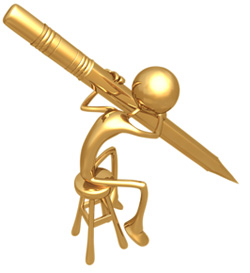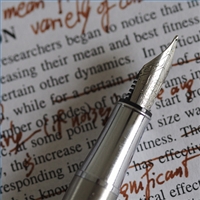Editing 101 or at least how I do it
The very sweet from Debra from Lifescapes was kind enough to ask me about my editing process which is a little hard to pin down but I’ll try to write a bit about it here and not bore you all too much.
Now every time I write a book it’s a new and different process. I have written 5 full novels and quite a few partials which are sample pages of novels that are ideas in work. A little back-story before I get to the edits. I’m a pantsterwhich is a term for flying by the seat of your pants. Now, I wish this wasn’t true. I’d love to be a big time outliner and have every aspect of my story down cold before I start to write, but that’s just not true and even when I do have it and map it all out, the characters are like these “real” people in my head that seem to go off in their own directions at the oddest times. So then its map out the window and time to pull out the GPS. Well, somehow through all this I find my way to the end of a novel that looks remarkably like the “movie” I originally saw in my head way back when.
But being done is just the beginning. My grammar and spelling, as most of you long time blog readers can attest to, is just a hot mess besides that, who knows if I changed a characters eye or hair color way back in chapter 3 and not even noticed. Heck, I may have changed a name. Writing a story is a long process.
Coming to the rescue is my critique group. I have a core group of 3 writer friends that I havehad for years I call them my Writing Vault and they are invaluable to me. We read for each other and give loving but very real feedback. No just easy pats on the back here. So I’ll send the manuscript off to one of them.
Opps Add in: Thanks Maira for reminding me. First I print out a full copy and read it through myself and red line edit it once going through all the way with a full read. This is usually painful. Ouch.
Then off to crit partners and they will edit the whole book with bold red track changes with all their thoughts on grammar, seeing if I’ve totally fleshed out an idea, have enough emotion etc… then I go back and make whatever changes (I agree with) I want to the entire book. Then I’ll do this again with another critique partner until I feel the work is the best that I can make it. I can’t put a time on this as it can be quite long depending on life and how much work the book needs. I’m not a quick writer and it’s different for each book.
Now this process doesn’t work for all writers. I know many published authors that don’t work with readers at all, but for me the help and mostly the caring and support has kept me writing through the years even in the face of rejection.
I am eternally grateful to my critique group. Thanks so much Megan, Jen and Jeanine. May all our writing and publishing dreams come true.
So tell me, what’s your editing process?
Best,
Kwana



10 Comments
Ina in Alaska
I am not a writer but I like to get my point across in a very brief manner. Short and sweet. I edit out “blabby-ness” and overdone details because they are boring, confusing and a terrible waste of time. This is likely due to my many years of working in a law firm. The less said, the better. I think my blog is pretty much like that. Short and to the point (like the license plates I admire so much).
Have a great weekend, Kwana! xoxoxo
Maria Geraci
Once I finish the first draft, I let it sit as long as possible, which might not be too long if I’m on a deadline. Then I print it out and read it and make notes and go back in and edit. Then I reread it again and go chapter by chapter, scene by scene until it starts to feel like it’s coming together. Unfortunately (or fortunately!), all my original critique partners are also published and none of us have time to do crits anymore. So I give it to a few beta readers. Friends who I know will tell me what they like or don’t like in a general way, but who are not writers themselves.
At this point, then I show it to my editor who adds in her two cents worth and then I go back and edit and edit some more until I get a call from her assistant who says “We have to have the manuscript now!” Sigh. then I reluctantly let go of it…
Lots more than you wanted to know, right?
kwana
Thanks for that Ina. Simple is better.
Not more than I wanted to know Maria and thanks for reminding me about my full print out that I do myself I had forgotten about that step. I do that too.
pve
I just hope that some-where in that book is a little line dedicated to Jack.
pve
Amanda McCabe
LOL! Pantser writers unite. 🙂
Since I write my rough draft out in longhand (very Bronte-esque, but I just can’t seem to think creatively any other way!) the first step in editing is typing it up (if I can read my handwriting) and seeing where the weak spots are
Jeanine McAdam
I agree critiques must be done in a supportive yet firm environment!! Thanks much for your post and all your critiques of my stuff.
Jen
I always learn so much from critiques and it’s wonderful to see such amazing authors change and grow. Writing is lonely work and impossible to do without friends who get that.
Laurie at mizwrite
Awesome post, Kwana! I’m a pantser, too. (Which is getting me in a lot of trouble with some endings, mind you!)
(But it’s great for pacing, right? I think pantsers are the best pacers!)
Anyway, I do much the same as you do, but I divide my edits into three groupings: after having others read first draft, the 1st edit is all about fixing any plot problems and holes; then I go back over with a 2nd edit that’s all about fixing characters (making dialogue consistent for their speech, making all eye color references the same! ha!); then I go back over a last time in 3rd edit which is all about fixing the words (better word for “run,” deleting unnecessary “that’s” and unnecessary adjectives, etc.). I love the 3rd edit, and dread the 1st!
Fun post. It’s always fun to read others’ writing processes!
Debra
Geeez Kwana~ What a process! Could I hire you to edit my blog posts??? I wish I were close enough to cook a meal for you and your family during all of this. I know you are good at this and love it! Thank you so much for explaining this. Rest up this weekend!
Jay Tee
I swing between plotting and pantsing when I write, but when it comes to editing, I’m an absolute devotee of the AutoCrit Editing Wizard.
It really helps me find the weak areas in my manuscript and saves me a ton of time!